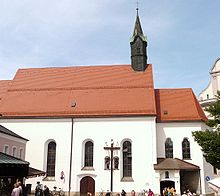Altötting Capuchin Monastery

The Capuchin monastery Altötting is a former monastery of the Franciscan Reformates , now the Capuchin in the pilgrimage site of Altötting in Bavaria in the diocese of Passau .
history
The monastery named after Saint Konrad von Parzham was founded in 1654 by Franz Wilhelm von Wartenberg , Prince-Bishop of Regensburg and provost of the Altötting collegiate monastery . The church was named after St. Anne out of gratitude to the widowed Electress Maria Anna .
In the course of secularization , the Franciscans were expelled to Ingolstadt and Tölz in May 1802 and the monastery was assigned to the Capuchin Order as an extinction monastery . Around 150 Capuchins from other closed Bavarian Capuchin monasteries were housed here. Under the rule of King Ludwig I , the Bavarian order province of the Capuchins was rebuilt from Altötting. Since then, the Capuchins have been taking care of the pilgrimage to the Holy Chapel with the miraculous image of Our Lady in Altötting.
On March 23, 1953, the Congregation for the Holy Rites allowed the previous St. Anne's Church to be renamed to the name of St. Brother Konrad von Parzham. In 1956/57 the church was redesigned accordingly by the Regensburg architect Beckers. In 1961 the previous St. Anna monastery was renamed the Brother Konrad Monastery .
layout
Nothing has been changed at the monastery gate since Brother Konrad's time, not even during the renovation of the monastery in 1959/60. From the gate passage , a door leads to the left into the Alexius cell , where Brother Conrad liked to pray in between, because from there he had a clear view of the altar. In the Alexius cell, letters of supplication and thanks are also sent to the saint.
In the church there is the reliquary of the saint under the canopy crowned altar . The bones rest in a silver figure, the head separate from it in a cover. The South Tyrolean sculptor Siegfried Moroder is the creator of the crucifixion group in the apse and the middle altar. Opposite the main portal of the church, Brother Konrad's memorabilia are kept in a museum. The crypt in which Brother Konrad was originally buried has also been accessible since 1965 .
The church was built in 1657 in the early baroque style. A simple building, as it is typical for Franciscans / Capuchins. A tower was omitted and a roof turret was implemented instead . On the back, the polygonal choir emerges as a separate structure. The incidence of light into the choir and the single nave nave with organ gallery is through long, arched windows.
Web links
literature
-
Altötting, Franciscan monastery , basic data and history:
Christian Lankes: Franziskanerkloster Altötting - In the service of the Black Mother of God in the database of monasteries in Bavaria in the House of Bavarian History - Franz Xaver Hoedl: Altötting. Guide and souvenir booklet for pilgrims to Altötting , Third Order Publishing House Altötting, 1977
Coordinates: 48 ° 13 ′ 37.6 ″ N , 12 ° 40 ′ 27.5 ″ E


